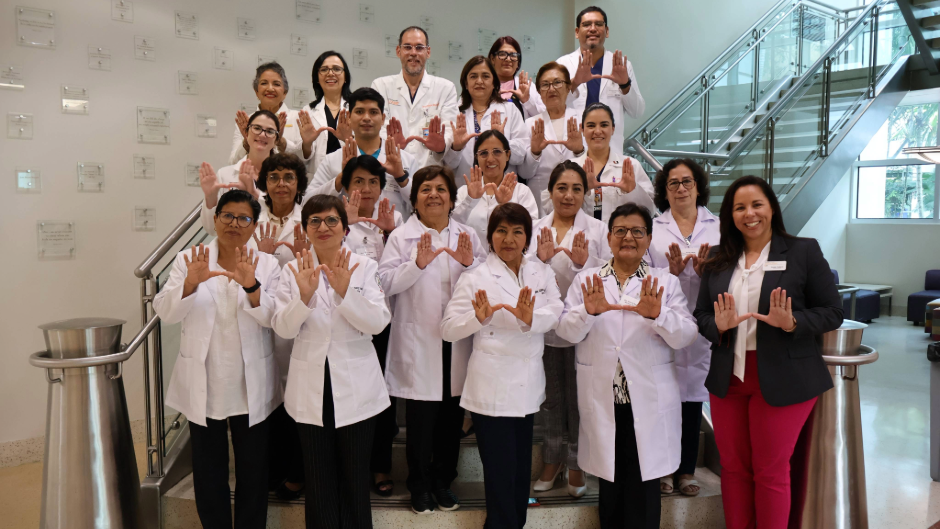A group of leading nurse educators representing over a dozen academic institutions throughout Peru flew thousands of miles and crossed the equator into the United States this summer in hopes of gaining insights into how simulation-supported learning can help prepare their country’s next generation of nurses to provide the best care possible.
They came from the mountains of Huaraz and Huancayo and the coastal towns of Chimbote and Barranca. They came from Lima and Lambayeque, Ayacucho and Arequipa, Cusco and Chachapoyas, Piura and Paturpampa. Their focus—a week-long intensive course designed by subject experts from the University of Miami School of Nursing and Health Studies (SONHS) and Simulation Hospital Advancing Research and Education (S.H.A.R.E.®).
“Estrategias para la Enseñanza Clínica con Simulación” (strategies for clinical education with simulation) ran from June 21 to 28. The long journey to Miami was worth it based on glowing evaluations and broad smiles from 17 veteran educators representing public and private nursing schools throughout Peru. One of those, Dr. Maria Elena Gamarra Sanchez, coordinator of the nursing school at César Vallejo University in Trujillo, Peru, has been a nurse for 35 years. She said she learned many strategies at S.H.A.R.E. that she can implement back home, in her school’s “basic simulation center,” to help faculty and students alike. “I am very grateful to the University of Miami,” she said. “This has been a marvelous experience.”
The faculty are members of Peru’s national association for nursing faculty and nursing schools, ASPEFEEN: Asociación Peruana de Facultades y Escuelas de Enfermería. ASPEFEEN’s president, Dr. Gianina Soledad Farro Peña, a principal professor at Universidad Peruana Cayetano Heredia, planned the collaboration with Dr. Johis Ortega, associate dean for Hemispheric and Global Initiatives at SONHS, after she toured S.H.A.R.E. during the Pan American Nursing Research Colloquium held November 2022 at SONHS.
Course participant Sonia Tejada Muñoz has been a nurse for 28 years and directs the nursing school at Universidad Nacional Toribio Rodriguez de Mendoza de Amazonas, where they have one simulator. The week’s simulation exercises gave her the chance to take on two different roles, teacher and assistant, and work on three different skills. “Learning about simulation for academic purposes in nursing is very interesting for me and for my students because it allows us to practice our nursing skills,” she said. “This experience is very important for me and my faculty in my country. I learned a great deal this week. Thank you, UM and professors.”
The simulation team at S.H.A.R.E. was equally enthusiastic. “I was excited to see 16 different universities from Peru that are committed to advancing the nursing education through simulation,” said nurse practitioner Dr. Michelle Arrojo, a graduate simulation educator at S.H.A.R.E.“ I was happy to see these esteemed faculty motivated to experience simulation like a nursing student would.”
Assisted as well by simulation technologist Didier Torres, the nursing faculty learned how to create clinical scenarios for their students, and how to pilot and execute the scenarios. They also practiced debriefing, reflective group discussions that take place after a simulation exercise is complete. They chose prevalent health issues such as hypertensive crisis, hyperglycemia, asthma exacerbation, and psychotic crisis around which to create scenarios.
“It was truly a great experience knowing that what we taught these professors will be reaching many different students and faculty from universities throughout the entire country of Peru,” said Michelle Osso, undergraduate simulation educator at S.H.A.R.E.
Dr. Amauri Quintana, graduate simulation educator, called the gratitude the educators expressed “genuinely humbling.”
“These individuals are not only faculty members, but also deans and vice deans at their respective universities,” added Quintana. “However, they all displayed a readiness to learn right from the start, regardless of their qualifications or years of experience, without any hint of ego. In general, the experience was exceptional. We received exceedingly positive and encouraging feedback from the participants, which was a great privilege.”
At week’s end, Associate Dean Ortega congratulated the group on completing the course, offering to serve as a resource on future collaborations. Another group from ASPEFEEN, including its president, Peña, is scheduled to take the course this October.
Zuzer Calero, executive director of business operations for S.H.A.R.E., explained, “Workshops such as this one allow us to nurture enriching partnerships with national and international institutions in ways that demonstrate the breadth and depth of S.H.A.R.E.’s ongoing commitment to lifelong learning.”

